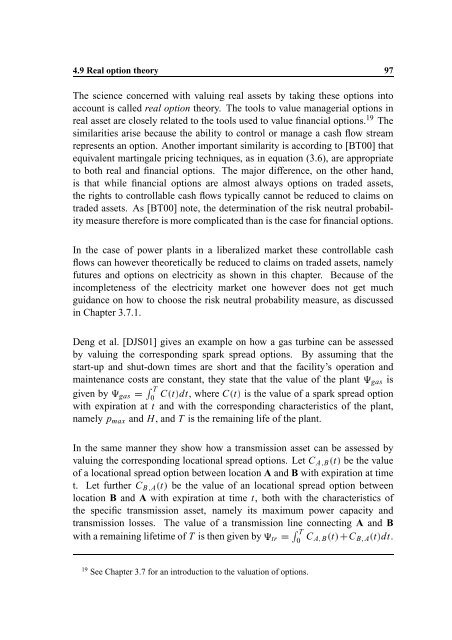Hedging Strategy and Electricity Contract Engineering - IFOR
Hedging Strategy and Electricity Contract Engineering - IFOR
Hedging Strategy and Electricity Contract Engineering - IFOR
Create successful ePaper yourself
Turn your PDF publications into a flip-book with our unique Google optimized e-Paper software.
4.9 Real option theory 97<br />
The science concerned with valuing real assets by taking these options into<br />
account is called real option theory. The tools to value managerial options in<br />
real asset are closely related to the tools used to value financial options. 19 The<br />
similarities arise because the ability to control or manage a cash flow stream<br />
represents an option. Another important similarity is according to [BT00] that<br />
equivalent martingale pricing techniques, as in equation (3.6), are appropriate<br />
to both real <strong>and</strong> financial options. The major difference, on the other h<strong>and</strong>,<br />
is that while financial options are almost always options on traded assets,<br />
the rights to controllable cash flows typically cannot be reduced to claims on<br />
traded assets. As [BT00] note, the determination of the risk neutral probability<br />
measure therefore is more complicated than is the case for financial options.<br />
In the case of power plants in a liberalized market these controllable cash<br />
flows can however theoretically be reduced to claims on traded assets, namely<br />
futures <strong>and</strong> options on electricity as shown in this chapter. Because of the<br />
incompleteness of the electricity market one however does not get much<br />
guidance on how to choose the risk neutral probability measure, as discussed<br />
in Chapter 3.7.1.<br />
Deng et al. [DJS01] gives an example on how a gas turbine can be assessed<br />
by valuing the corresponding spark spread options. By assuming that the<br />
start-up <strong>and</strong> shut-down times are short <strong>and</strong> that the facility’s operation <strong>and</strong><br />
maintenance costs are constant, they state that the value of º the plant gas is<br />
º<br />
T<br />
given by gas t›<br />
0<br />
C dt, t› where C is the value of a spark spread option<br />
with expiration at t <strong>and</strong> with the corresponding characteristics of the plant,<br />
namely p max <strong>and</strong> H, <strong>and</strong> T is the remaining life of the plant.<br />
In the same manner they show how a transmission asset can be assessed by<br />
valuing the corresponding locational spread options. Let C t› A» B be the value<br />
of a locational spread option between location A <strong>and</strong> B with expiration at time<br />
t. Let further A t› C B» be the value of an locational spread option between<br />
location B <strong>and</strong> A with expiration at time t, both with the characteristics of<br />
the specific transmission asset, namely its maximum power capacity <strong>and</strong><br />
transmission losses. The value of a transmission line connecting A <strong>and</strong> B<br />
with a remaining lifetime of T is then º<br />
T<br />
given by tr 0 C t› B C A t› B» dt.<br />
A»<br />
19 See Chapter 3.7 for an introduction to the valuation of options.
















